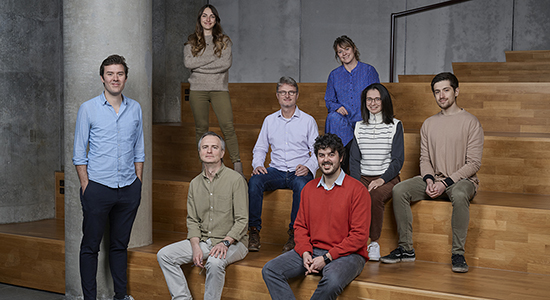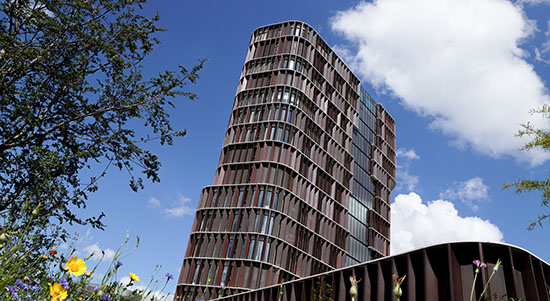Computational Chemistry Unit
The Computational Chemistry Unit provides state-of-the-art computational chemistry tools to the CBMR community.

We develop and apply cutting-edge computational methods to enable structure-based discovery and medicinal chemistry optimization of pharmacological tool compounds and drug candidates. These are used to characterize the physiological role of new metabolic target proteins discovered by CBMR researchers to advance basic science and to promote innovation at the center.
The Computational Chemistry Unit (CCU) aims to develop pharmacological tool compounds for metabolic target proteins identified at the Center. These tool compounds enable CBMR scientists to characterize the mechanistic action of new potential drug candidates in the context of human disease forming the basis for translational research and spinout companies.
We offer:
- Structure and ligand-based screening campaigns
- Design, development and handling of target-focused chemical libraries
- Running state-of-the-art biochemical and cellular in vitro assays for selected target proteins
- Initial guidance on innovation and intellectual property (IP) related topics
When CBMR researchers identify new biological target molecules which potentially could be involved in the development or treatment of diabetes and obesity, pharmacological tool compounds (drug candidates) are needed to validate these target proteins.
The Computational Chemistry Unit supports efforts to develop selective and potent leads and drug-candidates to prove the function of these target molecule and to serve as key components in establishing intellectual property rights (IPR).
Our Unit develops and applies unique computational chemistry methods for target pocket-analysis and structure-based ligand discovery. This technology enables generation of highly target-focused libraries of compounds cherry-picked from large commercial, stock-available screening libraries without the need of pursuing expansive high-throughput screening campaigns.
Thus, relatively few compounds are being physically tested in high content biochemical or in vitro and ex vivo cellular functional assays, which is ideal for an academic setting. Proof-of-concept for this type of academic compound/drug discovery technology has been generated at the Unit for several metabolic targets, i.e. metabolite GPCRs as well as enzymes and DNA-binding proteins.
Such novel compounds have not only improved the basic metabolic research at the Center, but have also resulted in several patents and served as the basis for innovation projects and generation of biotech spin-out companies.
- In house chemical libraries (>35.000 compounds) focused on metabolic target proteins
- Virtual chemical libraries (>1.3 billion compounds), pre-processed for rapid virtual screening campaigns with synthesis time of 3-4 weeks (CRO)
- High-end computing facilities, including 8 graphical processing units (GeForce GTX 1080 Ti/RTX 2080)
- Licenses to state-of the art computational modelling software (Schrödinger, Molsoft ICM)
Together with the Center researchers that have identified potentially novel metabolic target proteins, we will consider following aspects upon project initiation:
- Available ligand knowledge (known small molecule, peptide or protein ligands)
- Available structural information (x-ray, cryo EM, NMR)
- Setup of experimental assays for medium throughput (~50-100 comp.) screening campaigns
- Availability of orthogonal assays for hit validation
The core focus of Unit is related to translational pharmacology and rational design of next generation drugs. We use structure-based design technologies to discover ligands that can be developed into pharmacological tool compounds and early drug candidates. These can be used to characterize the physiological role of food and metabolite sensing receptors as well as other metabolic target proteins associated with the regulation of glucose homeostasis, adipose function and are considered high value targets for the treatment of metabolic diseases.
A major goal is to determine the mechanistic action of new drug candidates in the context of human disease and establish novel pharmacological paradigms that will result in the rational design of next generation drugs.
“Molecular dynamics-guided discovery of an ago-allosteric modulator for GPR40/FFAR1”
Published in PNAS in 2019, this paper describes how we used advanced molecular dynamics simulations to study the dynamics of a previously unexplored binding site in the free fatty acid receptor 1 (FFAR1). Using these insights, a compound designed to bind to this site was discovered as a novel ago-allosteric modulator for FFAR1. Two chemical series resulting from this discovery have been patented by the University of Copenhagen.
“Full monty of family B GPCRs”
Published in Nature Chemical Biology in 2017, this article describes the new structures of the glucagon-like peptide-1 (GLP-1) and glucagon receptors in complex with peptide and nonpeptide ligands that provide a comprehensive, detailed picture of the molecular mechanisms of action of family B GPCRs.
“Model-Based Discovery of Synthetic Agonists for the Zn2+-Sensing G-Protein-Coupled Receptor 39 (GPR39) Reveals Novel Biological Functions”
Published in Journal of Medicinal Chemistry in 2017, this study uses a homology model-based approach to identify small-molecule pharmacological tool compounds for the G-protein-coupled receptor 39 and identifies GPR39 as a novel regulator of gastric somatostatin secretion.
“Mutation-Guided Unbiased Modeling of the Fat Sensor GPR119 for High-Yield Agonist Screening”
Published in Structure in 2015, this study describes the development of a data-driven optimization protocol, which integrates mutational data and structural information from multiple X-ray receptor structures in combination with a fully flexible ligand docking protocol to determine the binding conformation of AR231453, a small-molecule agonist, in the GPR119 receptor.



